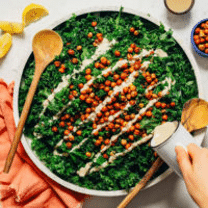
Sulforaphanes are a class of phytochemical. A phytochemical is:
Ever concern how you should consume these foods to get the benefits of the sulforaphanes from those bitter power filled foods? Continue reading! The enter getting the most nutrients is to slice the food to get the active part operating in our bodies. As soon as the cell walls of the brassica plant is broken down, the enzyme myrosinase launches an active cancer fighting chemical.
The meal noted below uses maple syrup in the tahini dressing to mask the bitter part of the kale.
Brassica or cruciferous veggies are the primary source of sulforaphanes. There are 375 series of brassica veggies that consist of arugula, bok choy, broccoli, broccoli rabe, brussel sprouts, cabbage, cauliflower, collard greens, dandelion, kale, mizuna, radicchio, radishes, and turnips, simply amongst others. The sulfur part of this phytochemical is what makes these foods bitter, that makes some people turn their nose roughly these power filled foods.
These foods can be consumed raw with salt to assist make them more bioavailable as in this meal (listed below), or gently steamed as these foods tend to be high in vitamin C, and the less heat the far better. If you do not like the bitterness, think of roasting with a pinch of sea salt to draw out the natural sweet taste of the plant or drizzle with some honey when roasting or after steaming or sautéing.
A product from plants that is not a vitamin or mineral No recognized necessary amount in the diet plan Have health promoting advantages.
Easy Massaged Kale Salad
Dish Source: Minimalist Baker at https://minimalistbaker.com/easy-massaged-kale-salad-15-minutes/
Image Credit: Minimalist Baker
Servings: 4
Active Ingredients
2 huge packages curly kale, big stems eliminated and approximately sliced 1 Tablespoon lemon juice 1 Tablespoon additional virgin olive oil (if avoiding oil, neglect) 1 healthy pinch sea salt
DRESSING
1/3 cup tahini 3 Tablespoon lemon juice 1-2 Tablespoon maple syrup (or sub agave, or honey if not vegan) 1 pinch sea salt (optional) Water to thin (~ 3-6 Tablespoon or 45-90 ml as initial dish is made up).
Crispy baked chickpeas.
GARNISHES optional.
Instructions.
1. Rinse and dry the kale. Eliminate the green leaves from the stalky stem.
2. Stack your stalks of kale on top of each other and carefully slice into bite-size pieces.
3. Place in a bowl and top with lemon juice and additional virgin olive oil. Massage the kale with tidy hands for about 3 minutes. The point of massaging is to impart the kale with the lemon juice and oil, and similarly to break down a few of the challenging, fibrous qualities of kale. This makes it simpler to soak up and chew and produces a more tender salad. Season with salt, massage/toss again, then reserved.
Include tahini, lemon juice, maple syrup, and salt (optional) to a medium mixing bowl. The mix may take up and thicken in the start, however continue including water a little at a time, blending till smooth and silky. Taste and alter taste as needed, consisting of more lemon juice for level of acidity, maple syrup for sweet taste, or salt to taste.
5. Leading with preferred amount of dressing and crispy chickpeas (optional), toss, and serve. Leftovers keep covered in the fridge roughly 3-4 days (not freezer friendly).
Serving: 4 parts.
Nutrition (1 of 4 portions).
Massage the kale with neat hands for about 3 minutes. The point of massaging is to impart the kale with the lemon juice and oil, and also to break down a few of the hard, fibrous attributes of kale. Taste and change taste as required, including more lemon juice for level of level of acidity, maple syrup for sweet taste, or salt to taste.
Audrey Caspar-Clark MS, RD, LDN, Doris Piccinin, MS, RD, CDE, CSO, LDN, Carly Roop, RD, CSO, MA, LDN, and Caroline Meehan, RDN, CSOWM, LDN, CDCES are the signed up dietitians at the Abramson Cancer Center at Perelman Center for Advanced Medication who focus on cancer nutrition and offer details based upon sound dietary treatments to support customers throughout their cancer treatment.
There are 375 varieties of brassica veggies that consist of arugula, bok choy, broccoli, broccoli rabe, brussel sprouts, cabbage, cauliflower, collard greens, dandelion, kale, mizuna, radicchio, radishes, and turnips, merely among others. The sulfur part of this phytochemical is what makes these foods bitter, that makes some individuals turn their nose roughly these power packed foods.
Calories: 183 Carbohydrates: 10.8 g, protein: 6.9 g, fat: 14.4 g, hydrogenated fat: 2 g, polyunsaturated Fat: 5.16 g, monounsaturated Fat: 6.5 g, trans Fat: 0 g, Cholesterol: 0 mg, Salt: 46 mg, Potassium: 315 mg, Fiber: 4.4 g, Sugar: 4.4 g, Vitamin A: 4013 IU, Vitamin C: 53.89 mg, Calcium: 81 mg, Iron: 2.22 mg.








